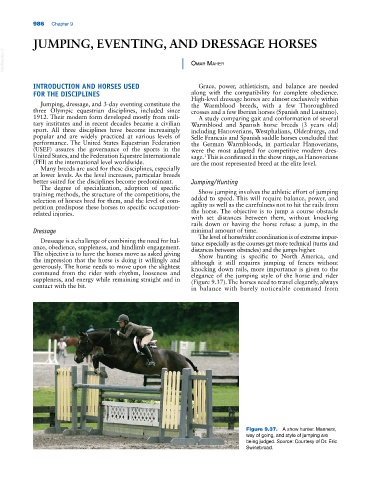Page 1020 - Adams and Stashak's Lameness in Horses, 7th Edition
P. 1020
986 Chapter 9
JUMPING, EVENTING, AND DRESSAGE HORSES
VetBooks.ir omaR maheR
INTRODUCTION AND HORSES USED Grace, power, athleticism, and balance are needed
FOR THE DISCIPLINES along with the compatibility for complete obedience.
High‐level dressage horses are almost exclusively within
Jumping, dressage, and 3‐day eventing constitute the the Warmblood breeds, with a few Thoroughbred
three Olympic equestrian disciplines, included since crosses and a few Iberian horses (Spanish and Lusitano).
1912. Their modern form developed mostly from mili A study comparing gait and conformation of several
tary institutes and in recent decades became a civilian Warmblood and Spanish horse breeds (3 years old)
sport. All three disciplines have become increasingly including Hanoverians, Westphalians, Oldenburgs, and
popular and are widely practiced at various levels of Selle Francais and Spanish saddle horses concluded that
performance. The United States Equestrian Federation the German Warmbloods, in particular Hanoverians,
(USEF) assures the governance of the sports in the were the most adapted for competitive modern dres
United States, and the Federation Equestre Internationale sage. This is confirmed in the show rings, as Hanoverians
1
(FEI) at the international level worldwide. are the most represented breed at the elite level.
Many breeds are used for these disciplines, especially
at lower levels. As the level increases, particular breeds
better suited for the disciplines become predominant. Jumping/Hunting
The degree of specialization, adoption of specific
training methods, the structure of the competitions, the Show jumping involves the athletic effort of jumping
selection of horses bred for them, and the level of com added to speed. This will require balance, power, and
petition predispose these horses to specific occupation‐ agility as well as the carefulness not to hit the rails from
related injuries. the horse. The objective is to jump a course obstacle
with set distances between them, without knocking
rails down or having the horse refuse a jump, in the
Dressage minimal amount of time.
The level of horse/rider coordination is of extreme impor
Dressage is a challenge of combining the need for bal tance especially as the courses get more technical (turns and
ance, obedience, suppleness, and hindlimb engagement. distances between obstacles) and the jumps higher.
The objective is to have the horses move as asked giving Show hunting is specific to North America, and
the impression that the horse is doing it willingly and although it still requires jumping of fences without
generously. The horse needs to move upon the slightest knocking down rails, more importance is given to the
command from the rider with rhythm, looseness and elegance of the jumping style of the horse and rider
suppleness, and energy while remaining straight and in (Figure 9.37). The horses need to travel elegantly, always
contact with the bit. in balance with barely noticeable command from
Figure 9.37. A show hunter. Manners,
way of going, and style of jumping are
being judged. Source: Courtesy of Dr. Eric
Swinebroad.

